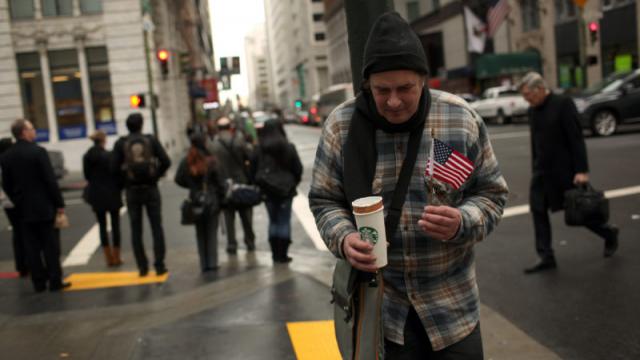
“Fact checker” Ballotpedia said that presidential candidate Jill Stein’s claim that “one in two Americans remain in or near poverty” was “untrue according to most conventional measures and definitions of near poverty.” But a responsible fact-checker should know that an issue of this magnitude demands more than a cursory look at “conventional measures” of poverty.
Furthermore, Ballotpedia may have been engaging in fake-fact checking. The service is run by the Lucy Burns Institute, a right-wing Koch–funded organization that has every incentive to avoid popular resistance by convincing Americans that they’re not really poor.
The Definitions of Poverty Are Way Out of Date
The poverty threshold is still based on a formula from the 1960s, when food expenses were a much greater part of the family budget. It hasn’t kept up with other major expenses. Since 1980, food costs have gone up by 100%, housing 250%, health care 500%, and college tuition 1,000%.
The Congressional Research Service (CRS) says, “If the same basic methodology developed in the early 1960s was applied today, the poverty thresholds would be over three times higher than the current thresholds.” Three times higher!
The median household income in the U.S. in 2016 was $59,039. The Economic Policy Institute’s 2015 Family Budget Calculator determined that the median budget for a two-parent, two-child family is $63,741. As CRS concluded, that’s about three times higher than the current poverty threshold.
In 2014, according to Bureau of Labor Statistics data, median household expenses were $36,800, against income of about $54,000. But that includes very little for wealth-building investments, such as short- and long-term savings, college education, and life insurance. After accounting for annual outlays for these essential and/or typical family expenses, the median household in the lower third was $2,300 in debt. For the middle third of households, which reaches well into the “middle class,” only $6,000 remained for wealth-building and other discretionary expenses. That $6,000 dissipates quickly. Says Pew Research: “Because income is measured before taxes, some families will have had even less slack in their budgets than this figure implies.”
Expenses Beyond the Essentials: Getting Higher & Higher
In the past 20 years median household expenses increased by 25 to 30 percent, while wages have stagnated. As a result, 3 out of 5 Americans spend more than they earn, not on frivolous extras, but on essential needs.
Housing, in particular, is crushing Americans. Nearly HALF of renters are cost-burdened, paying 30 or more of their income to their landlords. Renters in the poorest third of American households spend nearly HALF OF THEIR INCOME on housing.
Child care is another essential but overwhelming cost. The median American household in most states would have to spend over 10 percent of its income just to send a 4-year-old to full-time preschool. Children bear the brunt of a breakdown in society. The Center for Children in Poverty confirms that nearly half of our nation’s children live “dangerously” close to the poverty line.
Numerous other expenses are conveniently overlooked by the poverty skeptics: taxes; medical emergencies; car repairs; plumbing problems; appliance breakdowns; phone costs; work expenses, especially for members of the gig economy. As economist Constantin Gurdgiev puts it: “Quite frankly, it is idiotic to assume that gross median income matters to anyone. What matters is after-tax income net of the cost of necessities required to earn that income.”
Americans are Working Hard … Just to Survive
People are working more hours for decreasing wages and benefits. A Princeton study concluded that a stunning 94 percent of the nine million new jobs created in the past decade were temporary or contract-based, rather than traditional full-time positions.
It’s estimated that over three-quarters of Americans are living paycheck to paycheck, and about half of this group has reported “material hardship” (running out of food [or worrying about running out of food], not being able to afford a place to live or medical treatment, or having utilities turned off). Worse yet, most people who survive paycheck to paycheck are ill-prepared for the future. Only a third of workers are putting money into a 401(k). The median working-age couple has saved only $5,000 for retirement, and almost 70 percent of Americans have less than $1,000 saved.
The American Dream, Fading Away for Half of America
We still have our houses and cars, right? Maybe not. The poorest 50% of American adults had an average net worth (home and financial assets minus debt) of just $7,500 in 2016. A year earlier it was $9,000, but the richest 1% took it away, gaining an average of $1.5 million in that single year.
A revolution has to come. A peaceful revolution, ideally, toward a Guaranteed Income for everyone, paid for by a financial transaction tax and the removal of outlandish tax subsidies for the wealthy. Too many Americans have been cheated out of opportunities to share in our nation’s prosperity. Too many remain in poverty, or have fallen into poverty, or are beginning to experience its frightening symptoms.
Originally published by Nation of Change
3 WAYS TO SHOW YOUR SUPPORT
- Log in to post comments











